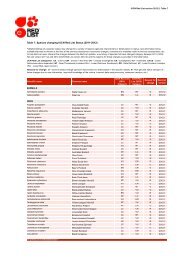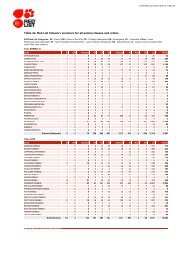IUCN Red List Guidelines - The IUCN Red List of Threatened Species
IUCN Red List Guidelines - The IUCN Red List of Threatened Species
IUCN Red List Guidelines - The IUCN Red List of Threatened Species
Create successful ePaper yourself
Turn your PDF publications into a flip-book with our unique Google optimized e-Paper software.
<strong>Red</strong> <strong>List</strong> <strong>Guidelines</strong> 20<br />
Although subpopulations typically have little demographic or genetic exchange, this may or<br />
may not amount to their complete isolation in this regard.<br />
4.3 Mature individuals (criteria A, B, C and D)<br />
“<strong>The</strong> number <strong>of</strong> mature individuals is the number <strong>of</strong> individuals known, estimated or<br />
inferred to be capable <strong>of</strong> reproduction. When estimating this quantity the following points<br />
should be borne in mind:<br />
• Mature individuals that will never produce new recruits should not be counted (e.g.,<br />
densities are too low for fertilization).<br />
• In the case <strong>of</strong> populations with biased adult or breeding sex ratios, it is appropriate to use<br />
lower estimates for the number <strong>of</strong> mature individuals, which take this into account.<br />
• Where the population size fluctuates, use a lower estimate. In most cases this will be<br />
much less than the mean.<br />
• Reproducing units within a clone should be counted as individuals, except where such<br />
units are unable to survive alone (e.g., corals).<br />
• In the case <strong>of</strong> taxa that naturally lose all or a subset <strong>of</strong> mature breeding individuals at<br />
some point in their life cycle, the estimate should be made at the appropriate time, when<br />
mature individuals are available for breeding.<br />
• Re-introduced individuals must have produced viable <strong>of</strong>fspring before they are counted as<br />
mature individuals.” (<strong>IUCN</strong> 2001)<br />
4.3.1 Notes on defining mature individuals<br />
This definition <strong>of</strong> mature individuals differs slightly from that given in version 2.3 <strong>of</strong> the <strong>Red</strong><br />
<strong>List</strong> Categories and Criteria (<strong>IUCN</strong> 1994). Some groups have found the more recent<br />
definition <strong>of</strong> mature individuals to be less conservative and less precise, leading to a<br />
potential down-listing <strong>of</strong> some taxa (e.g., obligate co-operative breeders) even though their<br />
extinction risk has not changed. It must be stressed that the intention <strong>of</strong> the definition <strong>of</strong><br />
mature individuals is to allow the estimate <strong>of</strong> the number <strong>of</strong> mature individuals to take<br />
account <strong>of</strong> all the factors that may make a taxon more vulnerable than might otherwise be<br />
expected. <strong>The</strong> list <strong>of</strong> points given with the definition is not exhaustive and should not<br />
restrict an assessor’s interpretation <strong>of</strong> mature individuals, provided they are estimating the<br />
number <strong>of</strong> individuals known, estimated or inferred to be capable <strong>of</strong> reproduction. <strong>The</strong><br />
ability <strong>of</strong> an assessor to estimate or infer which individuals are capable <strong>of</strong> reproduction is<br />
paramount and highly contingent on the particular features <strong>of</strong> the taxon or group. Juveniles,<br />
senescent individuals, suppressed individuals and individuals in subpopulations whose<br />
densities are too low for fertilization to occur will never produce new recruits, and therefore<br />
should not be counted as mature individuals. On the other hand, in many taxa there is a pool<br />
<strong>of</strong> non-reproductive (e.g., suppressed) individuals that will quickly become reproductive if a<br />
mature individual dies. <strong>The</strong>se individuals can be considered to be capable <strong>of</strong> reproduction.<br />
In general, the judgement will be best made by assessors with insight into the species’<br />
biology.<br />
In the case <strong>of</strong> taxa obligately dependent on other taxa for all or part <strong>of</strong> their life cycles,<br />
biologically appropriate values <strong>of</strong> mature individuals for the host taxon might be used. This






